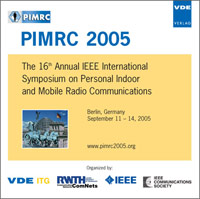Application-Level and User-Level QoS Assessment of Audio-Video Transmission with EDCA of IEEE 802.11e
Conference: PIMRC 2005 - 16th Annual IEEE International Symposium on Personal Indoor and Mobile Radio Communications
09/11/2005 - 09/14/2005 at Berlin, Germany
Proceedings: PIMRC 2005
Pages: 7Language: englishTyp: PDF
Personal VDE Members are entitled to a 10% discount on this title
Authors:
Suzuki, Takahiro (Faculty of Social and Information Sciences, Nihon Fukushi University, 26-2 Higashihaemi-cho, Handa, Aichi 475-0012 Japan)
Yamada, Kenta; Tasaka, Shuji (Graduate School of Engineering, Nagoya Institute of Technology, Gokiso-cho, Showa-ku, Nagoya 466-8555 Japan)
Kato, Masami (Personal Electronics Group, New System Equipment Unit, SANYO Electric Co., Ltd., 1-1 Sanyo-cho, Daitou, Osaka 574-8534, Japan)
Abstract:
This paper studies audio-video transmission in a wireless LAN with the EDCA of the IEEE 802.11e MAC protocol in terms of application-level QoS and user-level QoS (i.e., perceptual QoS). By simulation, we first compare the performance of the EDCA and the legacy IEEE 802.11 DCF in the case where audio, video, and data are transmitted in a common wireless channel. The EDCA supports priority control for multimedia transmission. Numerical results show that the EDCA can improve the audio and video quality of the DCF when data traffic load is heavy. We then study the effects of dynamic video-resolution and media synchronization control on the application-level QoS. Simulation results show that the two kinds of control at the application layer in addition to priority control with the EDCA at the MAC layer is effective in achieving excellent application-level QoS of audio-video transmission. Furthermore, we assess user-level QoS by the method of successive categories, which is one of the psychometric methods.


